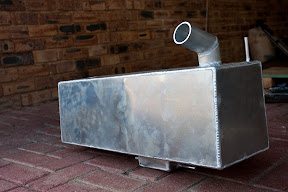
It would seem we were a bit optimistic regarding the side panels – the hope was that they would be completed by last week Tuesday. Needless to say it didn’t happen, although I really think we are almost there. The driver’s side panel has been completely cut out, and the top fold is done. Just the bottom folding is needed. The passenger side has been about half cut out, and the front fold is done.

A new trick we’ve been trying is to anneal the panel before folding. This involves heating the panel with a blow torch, and then allowing it to cool slowly. The temperature is indicated with soap – in our case good ol’ Sunlight liquid. When it turns black, it’s at the right temperature. This makes the folding much easier and more distinct, but tooling marks (i.e. when you bash it with a hammer) show up more easily.
Why is it that we tend to realise that we’ve made a mistake an instant after it’s been made? A split second after sending that sms/email bi!tching about the boss, you realise you sent it TO the boss… It’s the same with cutting anything – 3 seconds after you make your final committing cut, you realise you’ve got it wrong. In our case, we cut the left panel exactly the same as the right – meaning the scratched non-laser film side would have to face out. Fortunately there was enough length to fix the mistake – phew! But it did slow us down a bit.

A comment that must be made – do not underestimate how long it will take you to do the body panels. Every piece must be carefully measured, cut, adjusted, cut some more, cleaned, sanded, water-papered, placed, marked, measured, calculated, marked, punched, drilled, drilled, cleaned, drilled, riveted. And if you need to put in a fold, you can add soaping, heating, clamping, hammering and cleaning to the list. There are anything from about 10 to 13 panels (depending on how you do it) – that is a lot of work. Buying the pre-cut, pre-folded panels is definitely worth considering if time is a factor in your build.

We have also largely shaped and bent the brake lines. To form curves (that don’t pinch the Bundy tubing) we cut a 50mm circular disk from a piece of chip-board. This was bolted to another piece of scrap board, and served as a shape against which the tube could be folded. A spare piece of tube was used to “calibrate” the folding tool.

Basically a couple of different folds were made, and the actual tube length “consumed” in the loop was measured. A couple of lines were then marked on the board to indicate where folds would need to be made to form a loop that consumed a given amount of tube length. This made it much easier to plan how to fold the tubing to finish with the end connector in the right place.

Below is a picture of our Locost SA fuel tank. Although we were very tempted to try to get one made (using the off-cuts from our paneling), we decided that it just wasn’t worth the effort. One reason is that apparently aluminium welding is not tolerant of gaps (unlike steel welding, in which it’s fairly easy to fill a gap). This meant that if our cutting was imperfect (highly likely) then it may not have been possible to weld the tank.

You may have noticed that the pictures on the website behave a little differently now. I really didn’t like the way that clicking on any of the picture jumped you straight into Flickr. This is a requirement of the Flickr terms of service. I have now begun the process of migrating to PicasaWeb (a google-based picture hosting site). It is not a small job, but I think it will be worth it. As a result I’ve been able to install the “Lightbox” plugin, which is what controls the pictures in the new funky way. Please let me know what you think.